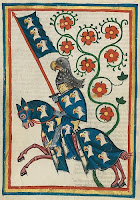The typical knight, the "basic" knight, was a "knight bachelor." This position existed in England during the reign of Henry III (1216 - 1272). The word "bachelor" denoted a junior rank, and had nothing to do with marital status. In fact, a wife gained some status when her husband was knighted. A knight bachelor would be addressed as "Sir John Smith" or "Sir John," and his wife would be addressed as "Lady Smith." The same naming convention applies in modern times.
The knight does not have any letters after his name the way, say, Members of the Most Excellent Order of the British Empire get to write "MBE" after their name. Conversely, you may be given an honor such as the Most Excellent Order of the British Empire, but this does not come with the honorific "Sir" or "Lady." It is an honor, not a title.
A 'knight banneret' was different from a knight bachelor. The outward sign that one was a knight banneret was, as the name implies, a knight who had a banner. Knights bachelor fought under the banner of their lord. A knight banneret could have his own coat of arms on a banner in battles, and could have his own contingent in battle who bore his standard. That standard was a squared banner, not a tapering standard or pennon (see illustration of a knight banneret).
The banneret was not a hereditary title like count or duke that could be passed to sons, but it had other benefits. The knight banneret would be paid more during war time. The wife of a knight banneret could be called banneress. Because the banneret title was given for valor in battle or special service to the king, it often led also, for the recipient, additional privileges such as other titles or estates. The 14th century saw some confusion when some knights banneret also were elevated as barons. Which designation was more appropriate? The resolution was to refer to the subject as a baron in a civil context and as a banneret in a military context, when they could request a higher rate of pay.The knight bachelor had no distinguishing insignia that would compare to the other's banner. In 1926, however, King George V authorized the wearing of a badge for knights bachelor on appropriate occasions. (Illustrated.)
The illustration at top is of Hartmann von Aue, a 12th-century German knight. Let's talk about him tomorrow.


No comments:
Post a Comment
Note: Only a member of this blog may post a comment.